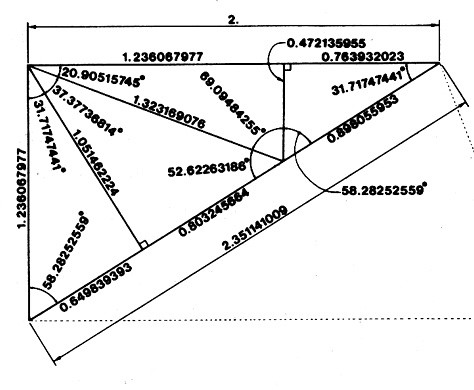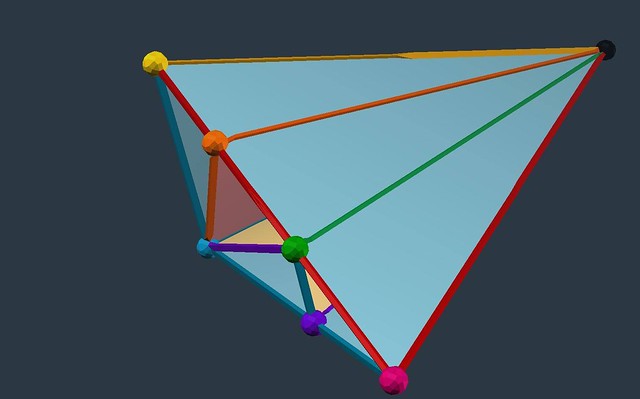#!/usr/bin/env python
# coding: utf-8
#
# # Bean Stalk Series: Dissecting the E & E3
# #### by D. Koski & K. Urner, May 2018 (version 1.2), last modified Feb 13, 2019
#
#
#
#
#
#

#
# Figure 1: E3 module dissected into Fum, Fo, Fi and Fe
#
#
#

#
#
#
#
#

#
# Figure 2: Dissected E-mod with color-coded vertexes (Koski with vZome)
#
#
# The black hub is at the center of the RT, as shown here...
#
#
#
#
#

#
# Figure 3: RT center is the black hub (Koski with vZome)
#
#
#
# The edges of the Fum module, tetrahedron Black-Orange-Yellow-Blue will be... (note R=1, D=2):
# In[2]:
# Edges needed for Fum and Emod
e0 = Black_Yellow = root3 * ø_down
e1 = Black_Blue = mpfr(1) # raddfius of RT = 1 (same as unit-radius sphere)
e2 = Black_Orange = 1/(rt2(ø**2+1)/2)
e3 = Yellow_Blue = (3 - root5)/2
e4 = Blue_Orange = (ø**-1)*(1/rt2(ø**2+1))
e5 = Orange_Yellow = rt2(Yellow_Blue**2 - Blue_Orange**2)
e6 = Black_Red = rt2((5 - root5)/2)
e7 = Blue_Red = 1/ø
e8 = Red_Yellow = rt2(5 - 2 * root5)
#print(e3 ** 2 + e7 ** 2)
#print(e8 ** 2)
#assert e3 ** 2 + e7 ** 2 == e8 ** 2 # check
#assert e4 ** 2 + e5 ** 2 == e3 ** 2 # check
# not needed for this computation
e9 = Black_Green = 20/(5 * root2 * ø**2) # Sfactor
e10 = Purple_Green = ø ** -4
for e in range(11):
val = "e" + str(e)
length = eval(val)
print("Edge {:3} = {:40.37}".format(val, length))
# In[3]:
import tetravolume as tv # has to be in your path, stored on Github with this JN
# D = 1 in this module, so final volume need to be divided by 8 to match R=1 (D=2)
# see Fig. 986.411A in Synergetics
Fum_vol = tv.Tetrahedron(e0,e1,e2,e3,e4,e5).ivm_volume()/8
E_vol = tv.Tetrahedron(e1,e0,e6,e3,e8,e7).ivm_volume()/8
print("Fum volume (in tetravolumes): {:40.38}".format( Fum_vol ))
print("E volume (in tetravolumes) : {:40.38}".format( E_vol ))
# In[4]:
Fe = (ø**-7) * (rt2(2)/8)
Fi = (ø**-6) * (rt2(2)/8)
Fo = ((5-rt2(5))/5) * (ø**-4) * (rt2(2)/8)
Fum = (rt2(5)/5) * (ø**-4)*(rt2(2)/8)
Fe_Fi = (ø**-5) * (rt2(2)/8)
Fo_Fum = (ø**-4) * (rt2(2)/8)
print("Fe: {:40.38}".format(Fe))
print("Fi: {:40.38}".format(Fi))
print("Fo: {:40.38}".format(Fo))
print("Fum: {:40.38}".format(Fum))
print("E_vol: {:40.38}".format((Fe_Fi) + (Fo_Fum)))
print("E_vol: {:40.38}".format((ø**-3)*(rt2(2)/8)))
# Lets start with a Pentagonal Dodecahedron and build it from Es + e3s.
# In[5]:
PD = 3 * root2 * (ø ** 2 + 1)
print(PD)
# In[6]:
E = e = E_vol # shorthand (E3 = E * ø_up ** 3, e3 = E * ø_down ** 3, E = e)
e3 = e * ø_down ** 3
PD = 348 * E + 84 * e3
print(PD)
# RT3, on the other hand, has a volume we may express as:
# In[7]:
RT3 = 480 * E + 120 * e3 # e3 is e * ø_down ** 3 (e = E)
print(RT3)
# Recall RT3 is the Rhombic Triacontahedron we get by intersecting the two Platonic duals: Icosahedron (Icosa) and Pentagonal Dodecahedron (PD), with the former having edges = 2R and volume ~18.51 (5 \* rt2(2) \* ø \*\* 2).
#
# It turns out that if we shave a Fum3 off an E3, and multiply by 120, we get the PD's volume.
#
# Put another way: RT3 - PD leaves a volume of 120 Fum3 volumes. In other words 120 * (E3 - Fum3) = PD.
# In[8]:
E3 = E_vol * ø_up ** 3
Fum3 = Fum_vol * ø_up ** 3
print(E3)
print(Fum3)
print(RT3 - PD)
print(120 * Fum3)
# As you can see, the relationship holds, though floating point numbers add some noise.
#
# In addition to edge lengths, we have a succinct way to express the angles of this LCD triangle in terms of ø, thanks to David Koski.
# In[9]:
from math import atan, sqrt as rt2, degrees
Ø = (1 + rt2(5))/2 # back to floating point
print(degrees(atan(Ø**-2)/2)) # 10.812316º
print(degrees(atan(Ø**-3))) # 13.282525º
print(degrees(atan(Ø**-2))) # 20.905157º
print(degrees(atan(Ø**-1))) # 31.717474º
print(degrees(atan(2*Ø**-2))) # 37.377368º
print(atan(Ø ** -1) + atan(Ø ** -3))
print(atan(1)) # arctan 1 = 45º
print(2 * atan(Ø**-1))
print(atan(2)) # 63.434948º
print(degrees(atan(2))) # 63.434948º
print( atan(Ø**-1) + 3 * atan(Ø**-3) )
print(atan(3)) # 71.565051º
print(degrees(atan(3))) # 71.565051º
# For Further Reading:
# * [Cuboidal E3](https://github.com/4dsolutions/Python5/blob/master/CuboidalE3.ipynb)
# * [Terminology and Scope](http://worldgame.blogspot.com/2017/10/terminology-and-scope.html)
# * [Escaping the Vortex of Standardized Tests](https://medium.com/@kirbyurner/escaping-the-vortex-of-standardized-tests-a-game-plan-84d77d75d100)
# * [S&E Modules (Python 3 Repl)](https://repl.it/@kurner/SandE-Modules)
# * [Figure 986.411A in Synergetics](http://www.rwgrayprojects.com/synergetics/s09/figs/f86411a.html)
 #
#